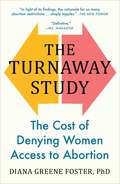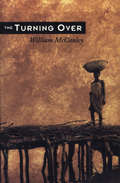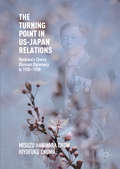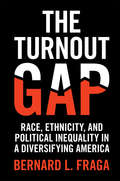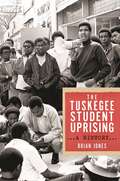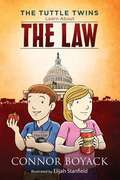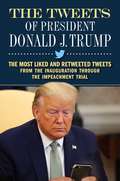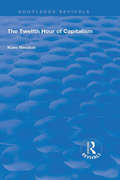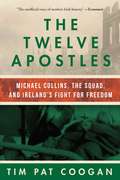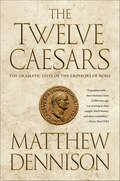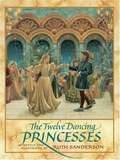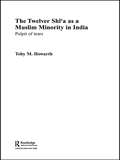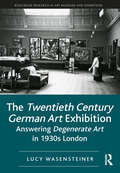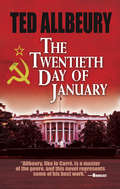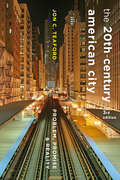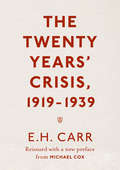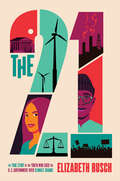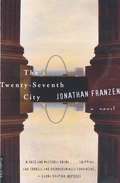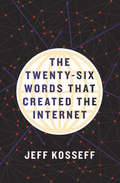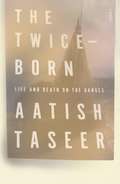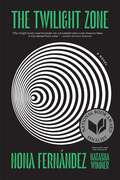- Table View
- List View
The Turnaway Study: The Cost of Denying Women Access to Abortion
by Diana Greene Foster&“If you read only one book about democracy, The Turnaway Study should be it. Why? Because without the power to make decisions about our own bodies, there is no democracy.&” —Gloria Steinem The &“remarkable&” (The New Yorker) landmark study of the consequences on women&’s lives—emotional, physical, financial, professional, personal, and psychological—of receiving versus being denied an abortion that &“should be required reading for every judge, member of Congress, and candidate for office—as well as anyone who hopes to better understand this complex and important issue&” (Cecile Richards).What happens when a woman seeking an abortion is turned away? To answer this question, Diana Greene Foster assembled a team of scientists—psychologists, epidemiologists, demographers, nurses, physicians, economists, sociologists, and public health researchers—to conduct a ten-year study. They followed a thousand women from across America, some of whom received abortions, some of whom were turned away. Now, for the first time, Dr. Foster presents the results of this landmark study in one extraordinary, groundbreaking book. Judges, politicians, and pro-life advocates routinely defend their anti-abortion stance by claiming that abortion is physically risky and leads to depression and remorse. Dr. Foster&’s data proves the opposite to be true. Foster documents the outcomes for women who received and were denied an abortion, analyzing the impact on their mental and physical health, their careers, their romantic relationships, and their other children, if they have them. Women who received an abortion were better off by almost every measure than women who did not, and five years after they receive an abortion, 99 percent of women do not regret it. As the national debate around abortion intensifies, The Turnaway Study offers the first thorough, data-driven examination of the negative consequences for women who cannot get abortions and provides incontrovertible evidence to refute the claim that abortion harms women. Interwoven with the study findings are ten &“engaging, in-depth&” (Ms. Magazine) first-person narratives. Candid, intimate, and deeply revealing, they bring to life the women and the stories behind the science. Revelatory, essential, and &“particularly relevant now&” (HuffPost), this is a must-read for anyone who cares about the impact of abortion and abortion restrictions on people&’s lives.
The Turning Over: A Novel
by William MccauleyFor several years, Robert Kelley lived a primitive and contented life in a fishing village in the mangrove swamps of Sierra Leone. There, he developed and managed a project that built a cooperative fisheries station to support remote coastal villages. His development work done, he reluctantly turns the station over to the corrupt government Fisheries Division, whom he knows from experience will simply steal its resources and go away, leaving the villagers poorer than ever. He travels to Freetown, the capital, to present his last report to his employer, an English development agency, and leave Sierra Leone for Mali to join Marie, with whom he's had an intermittent and intense love affair. But when he arrives in Freetown, his superior offers him another position, establishing and managing a new project in the heart of a politically unstable region of the country. Robert hesitates to accept, for he has already committed himself to joining Marie. His decision embroils him in unexpected and violent consequences. This love story of two expatriates is set against a lushly pictured West Africa in which the echoes of colonial, and even pre-colonial, life are still evident in the corrupting power of the Big Man and the equally corrupting privilege that surrounds white expatriate life. The Turning Over vividly portrays the last vestiges of that epoch in a world disintegrating into chaos.
The Turning Point in US-Japan Relations
by Misuzu Hanihara Chow Kiyofuku ChumaThis book analyses two international incidents in the 1920s shocked Japan and changed the way in which the country looked at the West. In the Paris Peace Conference, Japanese proposed Racial Equality Bill was defeated. In 1924, the US passed the immigration law that singularly excluded Japanese from immigration. Little known today, the two incidents made significant impact on Japanese mind-set. Detailed study of the two incidents reveals how they contributed towards the drastic transformation of Japan, from the liberal thinking Taisho Democracy in the 1920s to the violent rise of ultra- nationalism in the 1930s. Departing from a purely academic style writing, the story develops around the life of Hanihara Masanao, Japanese diplomat, Vice Minister of Foreign Affairs and ultimately the Ambassador to Washington during the fateful years of 1923-24. A unique pair of a Japanese Studies scholar in Australia and a leading investigative journalist in Japan undertook the work. Rigorous archival search extended over Japan, the United States, Australia and Europe resulted in a significant amount of new materials never published in English before.
The Turnout Gap: Race, Ethnicity, and Political Inequality in a Diversifying America
by Bernard L. FragaIn The Turnout Gap, Bernard L. Fraga offers the most comprehensive analysis to date of the causes and consequences of racial and ethnic disparities in voter turnout. Examining voting for Whites, African Americans, Latinos, and Asian Americans from the 1800s to the present, Fraga documents persistent gaps in turnout and shows that elections are increasingly unrepresentative of the wishes of all Americans. These gaps persist not because of socioeconomics or voter suppression, but because minority voters have limited influence in shaping election outcomes. As Fraga demonstrates, voters turn out at higher rates when their votes matter; despite demographic change, in most elections and most places, minorities are less electorally relevant than Whites. The Turnout Gap shows that when politicians engage the minority electorate, the power of the vote can win. However, demography is not destiny. It is up to politicians, parties, and citizens themselves to mobilize the potential of all Americans.
The Tuskegee Student Uprising: A History (Black Power #2)
by Brian JonesBCALA 2023 Nonfiction Award WinnerHistory of Education Society's Outstanding Book Award 2022 SemifinalistNamed one of the top 25 books all students should read by Tuskegee UniversityThe untold story of a dynamic student movement on one of the nation’s most important historically Black campusesThe Tuskegee Institute, one of the nation’s most important historically Black colleges, is primarily known for its World War II pilot training program, a fateful syphilis experiment, and the work of its founder, Booker T. Washington. In The Tuskegee Student Uprising, Brian Jones explores an important yet understudied aspect of the campus’s history: its radical student activism.Drawing upon years of archival research and interviews with former students, professors, and administrators, Brian Jones provides an in-depth account of one of the most dynamic student movements in United States history. The book takes the reader through Tuskegee students’ process of transformation and intellectual awakening as they stepped off campus to make unique contributions to southern movements for democracy and civil rights in the 1960s. In 1966, when one of their classmates was murdered by a white man in an off-campus incident, Tuskegee students began organizing under the banner of Black Power and fought for sweeping curricular and administrative reforms on campus. In 1968, hundreds of students took the Board of Trustees hostage and presented them with demands to transform Tuskegee Institute into a “Black University.” This explosive movement was thwarted by the arrival of the Alabama National Guard and the school’s temporary closure, but the students nevertheless claimed an impressive array of victories. Jones retells these and other events in relation to the broader landscape of social movements in those pivotal years, as well as in connection to the long pattern of dissent and protest within the Tuskegee Institute community, stretching back to the 19th century. A compelling work of scholarship, The Tuskegee Student Uprising is a must-read for anyone interested in student activism and the Black freedom movement.
The Tutor of History
by Manjushree ThapaNepalese writer Manjushree Thapa explores the themes of love, nationality, and indeed the destiny of a subcontinent, in this terrific first novel.
The Tuttle Twins Learn About the Law
by Connor Boyack Elijah StanfieldUntil now, freedom-minded parents had no educational material to teach their children the concepts of liberty. The Tuttle Twins series of books helps children learn about political and economic principles in a fun and engaging manner. With colorful illustrations and a fun story, your children will follow Ethan and Emily as they learn about liberty!
The Tweets of President Donald J. Trump: The Most Liked and Retweeted Tweets from the Inauguration through the Impeachment Trial
by Forefront BooksLove them or hate them, the tweets of President Donald J. Trump rule the Twitterverse.Until our last presidential campaign, television, particularly campaign ads, dominated the political landscape. But with the rise of Donald J. Trump came a new political tool: the internet. Trump used this to communicate instantly and very effectively with the American people. And it worked. Establishing his political positions by tweeting numerous times a day, Trump pulled a major upset by defeating Hillary Rodham Clinton to become the 45th president of the United States. Once in office, Trump did not abandon his penchant for using Twitter as his populist platform. Instead, he doubled down on it, making it his primary means of communicating with the American people. Knowing how effective a tweet can be, Trump once wrote, &“Boom. I press it and within two seconds we have breaking news.&” With a massive Twitter following of 78 million by the spring of 2020, Trump&’s direct impact upon Americans cannot be dismissed, nor can the value of his tweets as an essential part of the historical record be denied. To put the enormous impact of his tweets into perspective, Trump won the White House with 63 million votes—a number significantly lower than his massive Twitter following. Now you can read the collected tweets of wisdom—or ridiculousness—from President Donald J. Trump, from his inauguaration through February 2020 in this historically significant collection.
The Twelfth Hour of Capitalism (Routledge Revivals)
by Kuno RenatusFirst published in 1932. In this book, a well-known German authority on economics analyzes the present world situation and points the way out. His contention is that reparations are not in themselves enough to account for the crisis, which is rather due to the burden of interest that is being paid one way and another on the money sunk unproductively in the World War.
The Twelve Apostles: Michael Collins, the Squad, and Ireland's Fight for Freedom
by Tim Pat CooganIreland, 1919: When Sinn Féin proclaims Dáil Éireann the parliament of the independent Irish republic, London declares the new assembly to be illegal, and a vicious guerrilla war breaks out between republican and crown forces. Michael Collins, intelligence chief of the Irish Republican Army, creates an elite squad whose role is to assassinate British agents and undercover police. The so-called 'Twelve Apostles' will create violent mayhem, culminating in the events of 'Bloody Sunday' in November 1920. Bestselling historian Tim Pat Coogan not only tells the story of Collins' squad, he also examines the remarkable intelligence network of which it formed a part, and which helped to bring the British government to the negotiating table.
The Twelve Caesars
by Robert GravesThis ancient biographical history of Roman rulers from Julius Caesar to Domitian is translated by the acclaimed classicists and author of I, Claudius. As personal secretary to Emperor Hadrian, the second century scholar Suetonius had unlimited access to the Roman Imperial archives. Drawing on this wealth of source material, he wrote a sweeping account of the lives of Rome&’s first twelve emperors. From the empire&’s most accomplished leaders, such as Julius Caesar and Augustus, to its most depraved and doomed rulers, such as Caligula and Nero, this ancient biographical study presents an enlightening and colorful picture of these historical figures from remote antiquity. This edition of The Twelve Caesars is translated from the Latin by the renowned classicist, historian, and historical novelist Robert Graves. With his expertise in classical history and talent for telling a lively story, Graves presents an excellent translation that makes this classic work accessible to modern audiences
The Twelve Caesars: The Dramatic Lives of the Emperors of Rome
by Matthew DennisonThis vivid history of Rome and its rulers “combines thoughtful reflection and analysis with gossipy irreverence in a bewitching cocktail” (Daily Express, UK).One was a military genius, one murdered his mother and fiddled while Rome burned, another earned the nickname “sphincter artist”. Six of them were assassinated, two committed suicide—and five were considered gods. They are known as the “twelve Caesars” —Julius Caesar, Augustus, Tiberius, Caligula, Claudius, Nero, Galba, Otho, Vitellius, Vespasian, Titus, and Domitian. Under their rule, from 49 BC to AD 96, Rome was transformed from a republic to an empire, whose model of regal autocracy would survive in the West for more than a thousand years.In The Twelve Caesars, Matthew Dennison offers a revealing and colorful biography of each emperor, triumphantly evoking the luxury, license, brutality, and sophistication of imperial Rome at its zenith. But beyond recreating the lives, loves, and vices of these despots, psychopaths and perverts, he paints a portrait of an era of political and social revolution, of the bloody overthrow of a five-hundred-year-old political system and its replacement by a dictatorship which, against all the odds, succeeded more convincingly than oligarchic democracy in governing a vast empire.
The Twelve Dancing Princesses
by Ruth SandersonRetells the tale of twelve princesses who dance secretly all night long and how their secret is eventually discovered.
The Twelver Shi'a as a Muslim Minority in India: Pulpit of Tears (Routledge Persian and Shi'i Studies)
by Toby HowarthOne of the most important current debates within and about Islam concerns its relation with power. Can Muslims be fundamentally content without power or as a minority? This book considers the voice of an important Muslim minority through its sermons. Indian Shi'i Muslims are a minority within a minority, constituting about ten to fifteen percent of the population as a whole, but comprising of about fifteen million people. Ten sermons are presented entirely and many more are quoted in order to analyze the preaching tradition in full. This book is the first survey to present the Indian mourning gathering and explain the history of this extraordinary phenomenon.
The Twentieth Century German Art Exhibition: Answering Degenerate Art in 1930s London (Routledge Research in Art Museums and Exhibitions)
by Lucy WasensteinerThis book represents the first study dedicated to Twentieth Century German Art, the 1938 London exhibition that was the largest international response to the cultural policies of National Socialist Germany and the infamous Munich exhibition Degenerate Art. Provenance research into the catalogued exhibits has enabled a full reconstruction of the show for the first time: its contents and form, its contributors and their motivations, and its impact both in Britain and internationally. Presenting the research via six case-study exhibits, the book sheds new light on the exhibition and reveals it as one of the largest émigré projects of the period, which drew contributions from scores of German émigré collectors, dealers, art critics, and from the ‘degenerate’ artists themselves. The book explores the show’s potency as an anti-Nazi statement, which prompted a direct reaction from Hitler himself.
The Twentieth Day of January: The Inauguration Day Thriller
by Ted Allbeury"Allbeury, like le Carré, is a master of the genre, and this novel represents some of his best work." — Booklist "A flawlessly structured plot." — Publishers Weekly"Uncannily predicted the rise of Donald Trump." — Slate.comIt's 1980 and the Cold War continues to rage. Seemingly out of nowhere, wealthy businessman Logan Powell has become President-elect and is only weeks away from assuming the most powerful position in the world on the twentieth day of January. Across the Atlantic, veteran British intelligence agent James MacKay uncovers shocking evidence that suggests something might be terribly wrong with the election. With the help of a reluctant CIA, MacKay sets out on a dangerous and daring mission to discover if the unthinkable has occurred: is President-elect Powell actually a puppet of the Soviet Union? Written by the bestselling author of The Crossing and Pay Any Price, this remarkably plausible thriller offers a heady mix of political intrigue and intense suspense — with the very future of America and the free world hanging in the balance. "Allbeury's novels have won a reputation not only for verisimilitude but for crisp, economical narration and high drama … there's no better craftsman." — Chicago Sun-Times"A most knowledgeable chronicler of espionage." — The New York Times Book Review "When I say Ted Allbeury knows where the bodies are buried I mean it literally. Truly a classic writer of espionage fiction." — Len Deighton, author of The Ipcress File
The Twentieth-Century American City: Problem, Promise, and Reality (The American Moment)
by Jon C. TeafordModern cities embody America’s successes and failures—while offering hope for the future.Throughout the twentieth century, the city was deemed a problematic space, one that Americans urgently needed to improve. Although cities from New York to Los Angeles served as grand monuments to wealth and enterprise, they also reflected the social and economic fragmentation of the nation. Race, ethnicity, and class splintered the metropolis both literally and figuratively, thwarting efforts to create a harmonious whole. The urban landscape revealed what was right—and wrong—with both the country and its citizens’ way of life. In this thoroughly revised edition of his highly acclaimed book, Jon C. Teaford updates the story of urban America by expanding his discussion to cover the end of the twentieth century and the first years of the next millennium. A new chapter on urban revival initiatives at the close of the century focuses on the fight over suburban sprawl as well as the mixed success of reimagining historic urban cores as hip new residential and cultural hubs. The book also explores the effects of the late-century immigration boom from Latin America and Asia, which has complicated the metropolitan ethnic portrait.Drawing on wide-ranging primary and secondary sources, Teaford describes the complex social, political, economic, and physical development of US urban areas over the course of the long twentieth century. Touching on aging central cities, technoburbs, and the ongoing conflict between inner-city poverty and urban boosterism, The Twentieth-Century American City offers a broad, accessible overview of America’s persistent struggle for a better city.
The Twenty Years' Crisis, 1919-1939: Reissued with a new preface from Michael Cox
by E.H. CarrE.H. Carr's Twenty Years' Crisis is a classic work in International Relations. Published in 1939, on the eve of World War II, it was immediately recognized by friend and foe alike as a defining work in the fledgling discipline. The author was one of the most influential and controversial intellectuals of the twentieth century. The issues and themes he develops in this book continue to have relevance to modern day concerns with power and its distribution in the international system. Michael Cox's critical introduction provides the reader with background information about the author, the context for the book, its main themes and contemporary relevance. Written with the student in mind, it offers a guide to understanding a complex, but crucial text.Now updated with a new preface from Michael Cox.
The Twenty-One: The True Story of the Youth Who Sued the U.S. Government Over Climate Change
by Elizabeth RuschCompelling and timely, award-winning author Elizabeth Rusch’s The Twenty-One tells the gripping inside story of the ongoing landmark federal climate change lawsuit, Juliana vs. United States of America. The Twenty-One is for readers of Christina Soontornvat’s All Thirteen, fans of Steve Sheinkin’s books, and anyone interested in the environment and climate change, as well as youth activism, politics and government, and the law. From severe flooding in Louisiana to wildfires in the Pacific Northwest to melting permafrost in Alaska, catastrophic climate events are occurring more frequently—and severely—than ever. And these events are having a direct impact on the lives (and futures) of young people and their families. In the ongoing landmark case Juliana vs. United States, twenty-one young plaintiffs claim that the government’s support of the fossil-fuel industry is actively contributing to climate change, and that all citizens have a constitutional right to a stable climate—especially children and young adults, because they cannot vote and will inherit the problems of the future.Elizabeth Rusch’s The Twenty-One is a gripping legal and environmental thriller that tells the story of twenty-one young people and their ongoing case against the U.S. government for denying their constitutional right to life and liberty. A rich, informative, and multifaceted read, The Twenty-One stars the young plaintiffs and their attorneys; illuminates the workings of the United States’s judicial system and the relationship between government, citizens’ rights, and the environment; and asks readers to think deeply about the future of our planet. Features extensive backmatter, including a timeline, glossary, call to action, additional resources, and photographs.
The Twenty-Seventh City
by Jonathan FranzenA classic of contemporary fiction, "The Twenty-Seventh City" shows us an ordinary metropolis turned inside out, and the American Dream unraveling into terror and dark comedy.
The Twenty-Six Words That Created the Internet
by Jeff Kosseff"No provider or user of an interactive computer service shall be treated as the publisher or speaker of any information provided by another information content provider."Did you know that these twenty-six words are responsible for much of America's multibillion-dollar online industry? What we can and cannot write, say, and do online is based on just one law—a law that protects online services from lawsuits based on user content. Jeff Kosseff exposes the workings of Section 230 of the Communications Decency Act, which has lived mostly in the shadows since its enshrinement in 1996. Because many segments of American society now exist largely online, Kosseff argues that we need to understand and pay attention to what Section 230 really means and how it affects what we like, share, and comment upon every day.The Twenty-Six Words That Created the Internet tells the story of the institutions that flourished as a result of this powerful statute. It introduces us to those who created the law, those who advocated for it, and those involved in some of the most prominent cases decided under the law. Kosseff assesses the law that has facilitated freedom of online speech, trolling, and much more. His keen eye for the law, combined with his background as an award-winning journalist, demystifies a statute that affects all our lives –for good and for ill. While Section 230 may be imperfect and in need of refinement, Kosseff maintains that it is necessary to foster free speech and innovation. For filings from many of the cases discussed in the book and updates about Section 230, visit jeffkosseff.com
The Twice-Born: Life and Death on the Ganges
by Aatish TaseerIn The Twice-Born, Aatish Taseer embarks on a journey of self-discovery in an intoxicating, unsettling personal reckoning with modern India, where ancient customs collide with the contemporary politics of revivalism and revengeWhen Aatish Taseer first came to Benares, the spiritual capital of Hinduism, he was eighteen, the Westernized child of an Indian journalist and a Pakistani politician, raised among the intellectual and cultural elite of New Delhi. Nearly two decades later, Taseer leaves his life in Manhattan to go in search of the Brahmins, wanting to understand his own estrangement from India through their ties to tradition.Known as the twice-born—first into the flesh, and again when initiated into their vocation—the Brahmins are a caste devoted to sacred learning. But what Taseer finds in Benares, the holy city of death also known as Varanasi, is a window on an India as internally fractured as his own continent-bridging identity. At every turn, the seductive, homogenizing force of modernity collides with the insistent presence of the past. In a globalized world, to be modern is to renounce India—and yet the tide of nationalism is rising, heralded by cries of “Victory to Mother India!” and an outbreak of anti-Muslim violence.From the narrow streets of the temple town to a Modi rally in Delhi, among the blossoming cotton trees and the bathers and burning corpses of the Ganges, Taseer struggles to reconcile magic with reason, faith in tradition with hope for the future and the brutalities of the caste system, all the while challenging his own myths about himself, his past, and his countries old and new.
The Twilight Struggle: What the Cold War Teaches Us about Great-Power Rivalry Today
by Hal BrandsA leading historian&’s guide to great-power competition, as told through America&’s successes and failures in the Cold War&“If you want to know how America can win today's rivalries with Russia and China, read this book about how it triumphed in another twilight struggle: the Cold War.&”— Stephen J. Hadley, national security adviser to President George W. Bush The United States is entering an era of great-power competition with China and Russia. Such global struggles happen in a geopolitical twilight, between the sunshine of peace and the darkness of war. In this innovative and illuminating book, Hal Brands, a leading historian and former Pentagon adviser, argues that America should look to the history of the Cold War for lessons in how to succeed in great-power rivalry today. Although the threat posed by authoritarian powers is growing, America&’s muscle memory for dealing with dangerous foes has atrophied in the thirty years since the Cold War ended. In long-term competitions where the diplomatic jockeying is intense and the threat of violence is omnipresent, the United States will need all the historical insight it can get. Exploring how America won a previous twilight struggle is the starting point for determining how America can successfully prosecute another high-stakes rivalry today.
The Twilight Zone: A Novel
by Nona Fernández* Finalist for the National Book Award for Translated Literature *An engrossing, incantatory novel about the legacy of historical crimes by the author of Space InvadersIt is 1984 in Chile, in the middle of the Pinochet dictatorship. A member of the secret police walks into the office of a dissident magazine and finds a reporter, who records his testimony. The narrator of Nona Fernández’s mesmerizing and terrifying novel The Twilight Zone is a child when she first sees this man’s face on the magazine’s cover with the words “I Tortured People.” His complicity in the worst crimes of the regime and his commitment to speaking about them haunt the narrator into her adulthood and career as a writer and documentarian. Like a secret service agent from the future, through extraordinary feats of the imagination, Fernández follows the “man who tortured people” to places that archives can’t reach, into the sinister twilight zone of history where morning routines, a game of chess, Yuri Gagarin, and the eponymous TV show of the novel’s title coexist with the brutal yet commonplace machinations of the regime.How do crimes vanish in plain sight? How does one resist a repressive regime? And who gets to shape the truths we live by and take for granted? The Twilight Zone pulls us into the dark portals of the past, reminding us that the work of the writer in the face of historical erasure is to imagine so deeply that these absences can be, for a time, spectacularly illuminated.
The Twilight of Unionism: Ulster and the Future of Northern Ireland
by Geoffrey BellThe crisis of Ulster Unionism and the future of Northern IrelandThe fissures that have split the United Kingdom in the last decades have run through Northern Ireland. Since the 1998 Good Friday Agreement, the fragile peace has been threatened by Brexit, the rise and fall of the D U P and the failure of power-sharing arrangement between the main parties at the Stormont Assembly. As the very future of Northern Ireland is now in jeopardy, will Britain face up to its imperial legacy and address the deep inequalities that remain in the aftermath of the Troubles, and the uneven development of the 'New Ireland'?Geoffrey Bells offers an insightful history of Ulster Unionism from the 1960s to the present day. In recent years this has come to a crisis point. What is the future of the Union in the post-Brexit reality? How will the relationship between Northern Ireland and Westminster develop? Can the United Kingdom survive?
